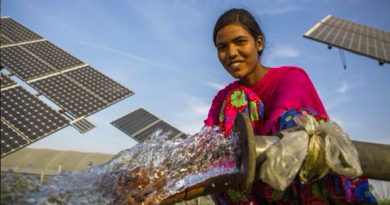Global Round Up

1.Renewables to bring energy independence to Ukraine
Post its standoff with Russia and heavy reliance on Poland and Hungary for expensive gas, bolstering renewable energy is the way forward to bring energy security and independence. While the share of energy Ukraine gets from renewable sources is still quite low, at 1.2 percent in 2017 (2.086 million kilowatts), the market is growing rapidly.
Optimistic forecasts see Ukraine obtaining nearly all of its power from renewable sources by mid-century. But this “revolutionary scenario” would require significant investment and development of infrastructure. Ukrainian company UDP Renewables plans to invest $200 million in the Ukrainian renewable industry and build solar power plants in Zaporizhzhya, Kyiv, Odessa, and Kherson. With a population of 45 million and enough potential for solar and more, Ukraine, subject to political and economic stability could be a very safe bet for renewables, simply because of its past history. The country can be trusted to bear any minor hardship for energy independence, considering its past history with Russia.
2. Renewables tied with Nuclear in the US for percentage in Energy Mix
The Energy Information Administration (EIA) published its ‘Electric Power Monthly’ report this week, revealing the latest energy statistics across the country for and through to the month of April and the figures continue to show the continued growth of the renewable energy industry and the decline of the country’s coal industry.
For the month of April, coal generated a total of 73,489 megawatt-hours (MWh), or 24.3% of the country’s total net generation. Natural gas continued to dominate with 100,004 MWh, or 33%, while nuclear and renewables continued to battle it out — nuclear with 19.5% and renewables with 22% (all renewable energy sources including hydroelectric).
3. Pension funds snap up £701m stake in EDF Renewables wind farms
The growing interest from pension funds and infrastructure investors in renewables projects was underlined late last week, as Dalmore Capital Limited and Pensions Infrastructure Platform snapped up a £701m stake in 24 UK wind farms owned by EDF Renewables.
The investment, which sees the firms acquire a 49 per cent minority stake in the 550MW portfolio, was backed with investment from large UK local authority pension schemes. Renewable firms have been favoured simply because of their perceived predictability to deliver an ‘annuity’ income in the form of dividends or fixed returns. Its one of the reasons the sector has attracted a lot of money. Let’s hope climate change does not upend those projections too much.
4. Renewable electricity helps Gatwick Airport achieve carbon neutrality
Gatwick Airport has been amongst the world’s first airports to achieve 100% carbon neutrality – and the first London airport to attain this status. Airports Council International (ACI) Europe provided Gatwick with carbon neutral certification in 2017. This was possible because of the airport’s use of 100% renewable electricity to run the airport and the Gold Standard carbon credits that offset its ground fuel emissions.
The Decade of Change programme is to be credited for this achievement for it’s ambitious environmental and community-focused targets. A key factor underpinning the achievement is the airport’s decision, in 2013, to start purchasing renewable electricity supplied by Haven Power.
“Haven Power had a strong commercial offer and was able to supply what we were looking for: renewable electricity… Since then, we’ve renewed twice because they manage the basics – including the complexities of our billing – very well, and support our day-to-day operations,” said Martin Bilton, Engineering Manager (Utilities), Gatwick Airport Limited after the airport renewed its contract with Haven Power. Readers will recall our own Kochi Airport going green, besides a very strong record at Mumbai’s T2 also.
copyright:iamrenew.com




